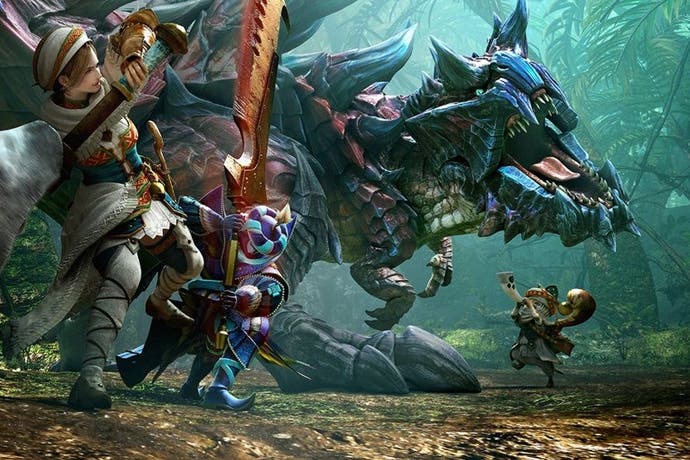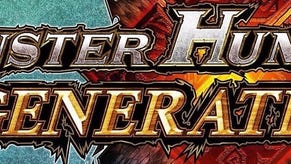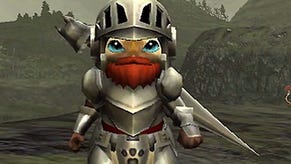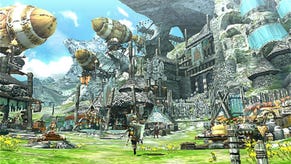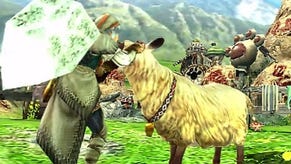Monster Hunter: Generations review
Fangs for the memories.
Being a long-time fan and a three-time reviewer of Monster Hunter, I feel like I've seen it all. I must have sunk somewhere between 500 and 750 hours of finger-cramping killing and crafting into Capcom's series, and, although I'm not exactly a god-tier G-Rank player, I know my way around a Kut-Ku's cojones. Nonetheless, each iteration of the series manages to do just enough with its new lick of paint to keep me coming back for more - gilding that wonderful lily of the central gameplay loop with near-perfect filigree.
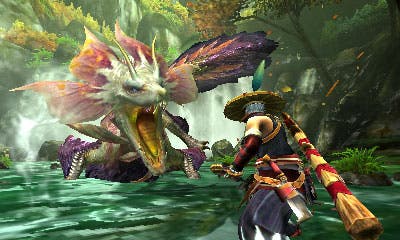
For me, Monster Hunter 4 Ultimate was the apex of the series so far, recovering perfectly from the misstep of Tri's clumsy underwater combat by adding dry-land verticality and the frenzied rodeo of monster mounting. Refreshing the mechanics without disturbing the series' perfect balance of difficulty, charm and achievement, MH4U's tinkering left me wondering whether there was anywhere left for the developers to go.
So I approached Generations with some caution. The changes here are considerable, with deep ramifications for combat, and I feared that this might have been one facelift too many. Thankfully, Monster Hunter is more Clooney than Wilderstein, and the new features add another charming wrinkle to its sparkling smile.
It's worth mentioning here that I'm going to assume a rough working knowledge of the game before I go on - but if you need to know the basics, take a look at the sidebar below for the key concepts.
The marquee innovation in Generations is the addition of styles and arts: essentially, stances and special moves. Now, for every one of the game's 14 different weapons, there are four different broad styles to choose from, and dozens of specials. That means 56 basic approaches with thousands of potential configurations. Almost impossibly, Monster Hunter just got a lot more complicated.
You'll probably ease yourself in with the Guild Style, which keeps each weapon's moveset from 4U and allows you to pick a couple of arts. Guild style is made for veterans, but it's also probably the easiest route into the game, too, balancing the introduction of the new options with a familiar combat routine. Slightly more advanced is the Striker style, which restricts your weapon's moves slightly, swapping some flexibility in exchange for an extra art slot to allow for bigger impacts. Aerial style is an acrobatic regime which lets hunters pounce and spring into the air from anywhere, massively increasing the chances of mounting a monster whilst restricting them to a single art. Finally, there's the pro-end adept style - a stance reliant on perfect countering and split-second timing which metes out punishing damage as a reward for risk-taking.
The arts themselves are pretty varied, but essentially fall into two categories: attacks and buffs. Each must be charged, either by attacking, gathering or the cheerleading of your Palicos, and unleashed with a tap of the touchscreen. Some are weapon-specific, some available to all, ranging from all-out aggression to defensive-counter postures and the deployment of healing stations.
As a salty old dog, afraid of new tricks, I spent too long in the comfortable embraces of the familiar Guild style and my go-to weaponry, and, because it uses the villages and maps of previous games, for some time Generations felt like a fugue rather than a greatest hits - a cynical recycling of old material. To some extent that is true: what's on offer here are new solutions to old problems, but they're new solutions which have me finding new fun in encounters I must have fought a hundred times before.
Take the combination of the aerial style and dual blades, for example. I've never been one for the series' double daggers - all whirling dervish and flashy pirouettes - instead opting for the staid and sturdy long sword, great sword or charge blade instead. But paired with the agility of the aerial style, Dual Blades come alive - turning your hunter into an angry tomcat, flung into the face of your adversary. On the other hand, take a long sword out as an aerial hunter and you'll find the combination a little jarring and restrictive; the wide, leaping slashes and sweeps are no real substitute for the ground-based spirit blade combo which the aerial style precludes.

But if there weren't a few dud combos in the mix, there'd be no point. Much of the joy here comes from switching up weapons, styles and arts in between hunts to find something which clicks for you - and whatever's next on your kill list. Up against a headlong charger? Chance your arm with a great sword and the Adept style for a slick, hard-hitting loadout - but one which will see you flattened like a chump if your timing is any less than perfect. If you're taking on one of the perpetually-in-motion apes like the Blangonga, you might want to combine the mobility of a sword and shield with the versatility of the striker style, to keep your options open. Still, there's not much more satisfying than combining an aerial stance with the lance, turning yourself into a divebombing Final Fantasy dragoon as you nail Rathians to the deck like a boss.
Arts and styles aren't the only new tools in the arsenal. The series has finally given in to the fan-service of giving you direct control of Palicoes with the new 'prowler missions'. In these, you can pick any of your stable of Felyne companions to be your lead hunter, accompanied by up to two others, and run free amongst the hills and harpies as a furry death squad. Not only do you get access to a completely new moveset (albeit one which can't be shifted with styles or arts), Prowlers have infinite stamina and don't need tools to gather, making them perfect for gathering missions.
Felynes get another boost with the introduction of customisable, transferable skills, too, letting you pick and choose both combat moves and support skills to fine-tune your back-up crew. And don't forget that you can dress them up as adorable idiots, too, with a whole new wardrobe of skins with which to humiliate your brave companions. Alongside the Palico Dojo, the other auxiliary systems which keep you occupied between hunts also get a do-over, with new mechanisms to deal with the automated Felyne gathering (Meownster Hunters and Felyne traders) as well as other training methods and enthusiasm recovery options. All kitchens are still run by Felynes, too, albeit now with a slightly uncomfortable hybrid of the ingredient-based systems of the past few games.
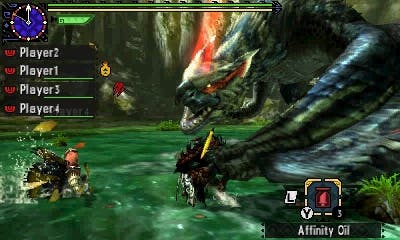
These little shifts are everywhere, and are clear evidence of a team which knows what makes this series tick, but can't resist the odd bit of embroidery. Mostly, they're successful, if still a little fiddly in places, but I have found it difficult to adapt to the changes which Capcom has made to the weapons upgrading system - arguably the key factor in the work/reward cycle which is the beating heart of the whole experience.
Armour upgrading remains largely the same - kill stuff, skin it, sew it together to make a suit, make it a better suit by adding armour spheres. Do that a couple of times, however, and you'll be presented with a different request - find materials to up the armour stats, much like weapons. Now, though, these are no longer specific materials - you'll instead be asked to meet a points total from a broad material type, such as ores or bones. Chuck enough earth crystals or iron ore into the mix and you should get by, but rarer materials will have higher point values. It makes sense, and isn't overused, and I'll be intrigued to see how it pans out in the end game.
Weapons don't fare so well. Whilst you can still craft them from scratch if you have the right materials, and weapon trees are very much still a core feature, you'll now need to upgrade the level of your weaponry to unlock the evolutions. For example, whereas a sword may have previously only evolved into one or two different weapons, which then had further development options, you can now skip some steps by levelling it up and directly transforming it into something much more advanced, if you have the monster bits to do so.
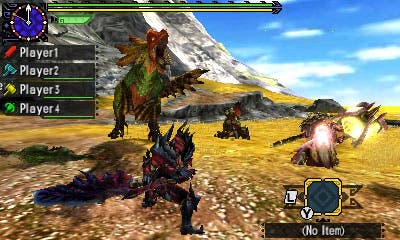
It's an odd system. In some ways, it's more transparent, letting you know that there are more options if you don't have the things you need to get to the next immediate step. On the other hand, it leads to you stockpiling a ridiculous amount of weaponry because you don't want to turn an eager cleaver into a devil slicer until you can level it up enough to find out what you get for leapfrogging that stage. Basically, it manages to make the whole process more confusing and unwieldy than ever before - quite the achievement when you're already dealing with a system containing hundreds of different stabby things.
What really grates, particularly for those who have been loyal for some time, is the vast amount of filler content. Your quest lists are going to contain more mushroom-picking, ore-gathering and god damn egg collection than ever, and it dilutes the good stuff to an almost unacceptable degree. I feel like I've traipsed around enough maps lugging bloody meteor fragments, spent enough time grubbing about in damp holes for fungi and endured enough virtual chain-ganging for minerals. I want the big stuff, the glory battles, the crowd pleasers; I want to be able to pass up the schlepping and concentrate on the actual Monster Hunting, and Generations has an annoying habit of hiding the good stuff behind a wall of fluff.
But it's not enough to drag the game down. The good stuff is in there, and in spades. Partly because of that quest bloat, Generations feels like the biggest Monster Hunter there's ever been. There are some bad decisions in evidence here - such as the disappointing backward steps in the early stages of the game, which returns to the fetch-quest heavy start which 4U had done such a good job of dispelling - but, generally, the changes are improvements.
If you're a veteran, bear in mind that you're going to have seen a lot of this before - there are precious few new enemies and no new maps at all (at least, 40 hours in there weren't), but be prepared to get outside your comfort zone by experimenting with new weapons and styles, and much of it will seem fresh again. Newcomers are undoubtedly going to find a lot of it bewildering, as always, and some of the very welcome good work in that regard has been undone - but it almost feels like the series has given up on acquiring new players for now, instead opting to give the ailing 3DS one last hurrah for existing fans before the inevitable debut on the forthcoming NX console. I suspect that when that happens, we'll see a rather more drastic makeover than we have with Generations. So, if you're looking for a 'best of', then this is the game for you.
